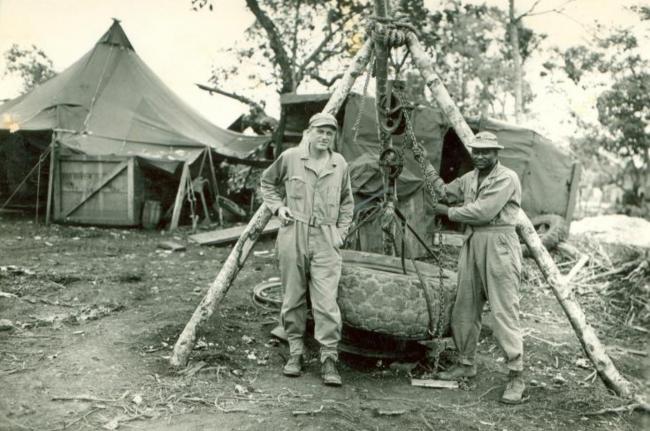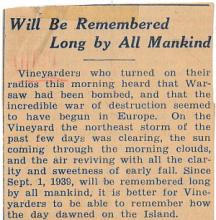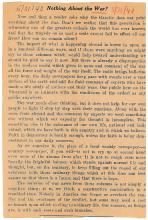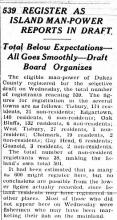Fifty years after the sinking of the United States naval fleet at Pearl Harbor, a group of Island veterans and their supporters gathered Dec. 7 in Oak Bluffs for breakfast to remember the day and honor their countrymen who lost their lives in this and other battles of World War II.
Every parking spot at the Veterans of Foreign Wars Hall on Towanicut avenue was filled at 9 a.m.
Well before President Bush was waking in the South Pacific to address the world by satellite, Peter Herman and Fred Phillips had been cooking tasty pancakes and grilling bacon to perfection in the small kitchen at the VFW.
At a dozen long tables covered with red and white checkered oilcloth, more than 60 people ate and chatted, downing their orange juice and coffee. Some of the men had their overseas caps folded and tucked in their belts. Three Cub Scouts, accompanied by their mothers, came in full uniform and took in the hall with wide eyes.
The place was rich in memories this Saturday morning. Judy Norton of Edgartown said she was too young in 1941 to remember Pearl Harbor, but she does remember the day World War II ended. She was coloring margarine with a little capsule full of red vegetable dye when the news came. Her husband Allen does remember the radio “squawking” the news of the Pearl Harbor attack.
“It's the kind of think you would always remember – like what you were doing the day President Kennedy was shot,” Mrs. Norton said.
Nelson Smith of Edgartown was seventeen when the attack came. He arrived home from work that fateful Sunday. His father, Stanley Smith, was looking for the atlas to find the location of Pearl Harbor. Nelson said, “My father was so mad. He wanted to sign up.” Nelson did too. He enlisted in every branch of the military service. The Sea Bees called him first, and his company built landing strips in the Aleutian Islands.
As people shared their memories at the VFW, the aroma of quahaug chowder joined those of pancakes and bacon. Coast Guard chef Larry Santos was in the kitchen stirring broth in a huge pot. He was making quahaug chowder for the annual tasting contest that day, and cleaning up from the breakfast preparations.
The three Cub Scouts were talking with animation, all happily full of pancakes and syrup. They were invited to the breakfast because they had marched at the Memorial Day parade this year in spite of the rain.
Peter Clough of Edgartown leaned back in his chair and recalled Dec. 7, 1941. He was in the Alpha Delta Phi fraternity house at Cornell University when “a guy came busting in the door and said the Japanese had hit Pearl Harbor. We though the thing would be over in two months,” he said.
Peter volunteered in August of 1942 and was called in October to serve in the anti-submarine patrol. His first assignment was aboard a 52-foot Alden schooner, Abanaki, built of wood. The crew of seven were on the lookout for U-boats. “We were a hit and miss operation,” Peter said, noting that U.S. Technology had yet to produce better defense equipment for the battle of the North Atlantic. He proudly pointed to a picture of the Coast Guard cutter Campbell hanging on the walls of the VFW. She was one of the great players in winning the war on the sea.
In a lounge adjoining the dining room of the VFW hangs a Japanese flag, the bright red symbol of the sun centered on a white field inscribed with Japanese writing. This is a body flag, said Al Hansen, who acquired it in Leyte. His ship Severn carried fresh water for the invasions in the Philippines. The Japanese, he said, contaminated all the drinking water wherever possible. They never knew the Severn was distilling salt water to fresh and supplying it in brand new fuel tanks for the troops, he said. Gen. Douglas MacArthur sailed by the Severn to make his famous return to the islands, Alan Hansen said.
Mary Ann Alwardt and her sister Florrie Ann Silva came to the breakfast. Their three brothers had served in World War II, and Mary and Florrie joined the women's auxiliary of the VFW as a support to them. Mary Ann's mother dressed her in a little girl's version of a WAVE uniform to greet her brothers when they came home. She and Mary Ann carry a little flag decorated with three shiny stars, one for each son, Mrs. Alwardt fondly remembers.
At 10 a.m., as thousands were preparing to gather at the Tomb of the Unknown Soldiers in Arlington Cemetery, Nelson Smith called the assembly in Oak Bluffs to order. As one voice, the breakfast crowd recited the pledge of allegiance to the flag. The Rev. William Grunden led the group in prayer and remembrance of those who had served and given their lives in World War II. With bowed heads people remembered those who made “the supreme sacrifice.” The hall filled with quiet and meditation. And in this silent way, they paid their homage.











Comments